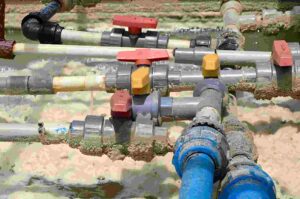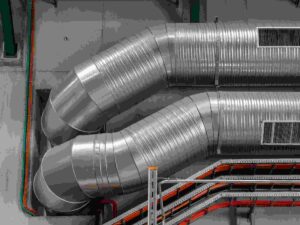What Is a Plumbing Vent Pipe and Why It Matters
A plumbing vent pipe is an important part that keeps everything going smoothly. When you think of plumbing, you probably think of water supply and drainage. Most of the attention is on pipes that carry water and waste, but air pipes keep your system safe, clean, and working well.
Your sinks, toilets, and drains wouldn’t work right without a good plumbing vent pipe. This guide describes air pipes, why they’re important, common problems they can have, and how to keep them in good shape.
What Is a Plumbing Vent Pipe?
A vent pipe which is also known as a vent stack does not carry water or trash. Instead it keeps the air pressure in your drainage system in check and lets sewer gases escape safely through the roof.
You can think of it as the “breathing mechanism” for the pipes in your home. The same way that your lungs need air to work your drain lines need air flow to keep wastewater moving.

Why Plumbing Vent Pipes Are Important
Vent lines are very important to the health of your home, even though you can’t see them. This is why they’re important:
- Prevents Sewer Gas Build-Up
Dangerous fumes, like methane, could build up inside without vents. They can get out of the building through a vent pipe. - Maintains Water Seal in Traps
A P-trap holds water to keep sewer gases from getting through. It’s in every washbasin and toilet. With the right opening, that water seal stays in place. - Ensures Smooth Drainage
Ventilation prevents negative air pressure that would otherwise slow or stop drainage. - Protects Plumbing Fixtures
From the washbasin in the kitchen to the toilet in the bathroom, properly vented drains reduce clogs, gurgling noises, and backflow.
How Plumbing Vent Pipes Work
The vent stack usually runs vertically through your home and exits through the roof. Putting trash water down a drain can make suction that can pull water out of traps nearby. The exit pipe lets air in to keep the pressure even, which keeps the water in the trap and the gases out.
Common Problems With Plumbing Vent Pipes
Systems that are built very well can still have problems with draining. Here are some problems that homes often have:
1. Clogged Vent Pipe
Roof vents can get blocked by bird nests leaves or other junk. This makes sinks move slowly smell bad or make gurgling sounds.
2. Poor Installation
If a house’s venting system doesn’t follow building rules it could lead to flooding issues that happen often.2
3. Frozen Vent Stack
When it’s cold outside, vent lines can freeze, which traps gases and makes the system less efficient.
4. System that is old or broken
Some old homes may have polybutylene lines or other old materials that don’t work as well as they should. Find out more about water issues with polybutylene.
Signs Your Plumbing Vent Pipe May Be Failing
- Strong, unpleasant smells inside the house
- Toilets or sinks that gurgle
- bathtubs or baths that drain slowly
- Toilet bowls’ water amounts going up and down
- backed up sewers, especially after it rains
If you notice these signs, you should call a plumber instead of trying to fix it yourself, which could be dangerous. For some problems, like roof vents that are jammed, you need special tools and to be careful.
DIY Plumbing Tips for Vent Pipes
While big fixes should be done by a professional, here are some plumbing tips that anyone can try:
- Visual Inspection: Look for things that you can see in the roof vent.
- Use a Garden Hose: Gently flush the vent to get rid of any clogs.
- Plunger Method: Sometimes plunging a sink or toilet can clear minor airlocks.
See these do-it-yourself plumbing tips for your kitchen sink and bathroom for more step-by-step help.

When to Call a Plumber
If vent problems don’t go away, you need to call a qualified plumber right away. Professionals can use special cameras to look inside lines and find blockages that are hidden. For instance, if you live in Georgia and need a plumber, hiring a Lawrenceville plumber from your area will make sure you get help quickly and in line with local rules.
For certain issues, like low water flow, you’ll need a plumber who knows how to fix more than just venting problems. To fix low water flow, learn how to find the best plumber.
Cost Considerations for Vent Pipe Repairs
The cost of vent repairs depends on:
- Where the blockage is (on the roof or underground)
- How long your plumbing has been around
- How hard it is to change where pipes go or replace them
Vent problems can happen at the same time as replacing fixtures. For instance, replacing a trash disposal might show that the venting isn’t working right. Check out the plumber cost to replace a garbage disposal for insights.
What Plumbers Handle Beyond Vent Pipes
Vent pipes are just one part of a plumber’s expertise. They also handle:
- Commercial plumbing services
- Fixture installations and repairs
- Sewer line replacements
- Emergency drain cleanouts (see this plumbing cleanout guide)
Many homeowners are curious about the profession itself—like how long it takes to become a plumber or the differences between plumber pay rate vs. hourly rate.
Best Practices for Modern Plumbing Systems
To keep the vent pipe and the rest of your drainage system healthy:
- Plan checks once a year
- Keep things out of roof vents.
- Update old tools to meet today’s standards
- Use devices that save water to ease the strain.
And while men have traditionally been more likely to work in plumbing, that is starting to change. Meet some female plumbers who are breaking gender norms and making home services better in the future.
Conclusion
The plumbing vent pipe is the unsung hero of your home’s drainage system. It keeps sewer gases out of your home, makes sure water flows smoothly, and makes sure faucets work right.
Vent lines are important to know about whether you have a clogged vent or are planning an upgrade. They help you keep your home safe and efficient. And the next time you call a plumber, you’ll know how important this pipe you forgot about really is.
To celebrate the people who keep our systems running, mark your calendar for National Hug a Plumber Day and show some gratitude for their essential work.
Frequently Asked Questions (FAQs)
Q1. What is a vent pipe for in plumbing used for?
The air pressure in your home’s drainage system is controlled by a plumbing vent pipe. This pipe lets sewer gases escape safely through the roof. Without it, drains can clog, gurgle, or allow unpleasant odors inside your home.
Q2. How can I tell if the air pipe in my roof is clogged?
These are some signs of a clogged vent:
- Drains making gurgling sounds
- Sinks, tubs, or toilets that drain slowly
- The house smells like sewers.
- There is water boiling or rising in the toilet bowl.
If you see these, you might need a professional to look at your air pipe.
Q3. Can I clear out my own water vent pipe?
There are times when yes. If you don’t mind being up high, you can look in the roof vent for things like leaves or bird nests that you can see and remove them. It might also help to flush the vent with an outdoor hose. If the blockage won’t go away, you should call a qualified plumber.
Q4. Where is the vent line for the plumbing?
Most vent pipes run vertically inside walls and exit through the roof. This is your major vent stack, which looks like a small pipe sticking up from the roof.
Q5. What will happen if I don’t fix an air pipe that is broken or clogged?
If you don’t fix a vent problem, sewer gas leaks, constant clogs, bad smells, and even pipe damage can happen. It can also be bad for the health of your family.